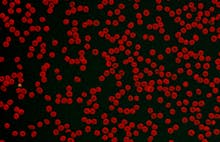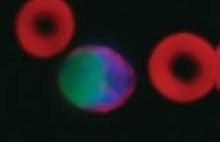Basophils: Definition, Abnormal High and Low Ranges
Leukocytes
Basophils Definition And Function
Basophils are a type of white blood cell. Like most types of white blood cells, basophils are responsible for fighting fungal or bacterial infections and viruses.
They are a granulocyte cell, which means that they release granules of enzymes to fight against harmful bacteria and germs. Basophils, neutrophils, and eosinophils are the three types of granulocytes in the body. Each of these releases different enzymes to fulfill a different role in the body’s immune response.
The enzymes that basophils release are called histamine and heparin. Histamine is a vasodilator. This means it widens the blood vessels near an infection to open and allow more blood flow to the site of the infection. Heparin is a naturally occurring blood thinning substance which prevents clotting.
Basophils are responsible for the body’s immune response during allergic reactions. When the body is exposed to an allergen, basophils release histamine which triggers the physical symptoms of an allergic reaction. This causes the typical allergic reaction of running nose, watering eyes etc.
They also help to produce a crucial antibody called immunoglobulin E (IgE). Immunoglobulin attaches to basophils and a similar type of cell called mast cells. The cells then work together to release histamine and serotonin, which affects the inflammatory response to the allergen.
Basophils: Normal And Abnormal Ranges
Even though basophils play an important role in our immune responses, they account for only around 0.1-1% of the body’s white blood cells. This count can be as low as 0.5%.
As an absolute count, an adult human should have 0 to 300 basophils per microliter of blood.
There usually are no symptoms for an abnormal range of basophils.
Causes Of Abnormal Basophils Range
Abnormally high and low counts of basophils can be caused by a variety of medical conditions.
A high count of basophils is called basophilia. This can be caused by hypothyroidism, a condition which occurs when the thyroid gland doesn’t produce enough thyroid hormone. If thyroid hormone is low, it can cause bodily functions to slow down.
Another reason for basophil count to be elevated can be a group of blood disorders called myeloproliferative disorders. These disorders cause too many white blood cells, red blood cells, or platelets to be produced in the bone marrow.
Such disorders include polycythemia rubra vera, myelofibrosis, and autoimmune disorders. Sometimes, although rarely, these disorders can progress into leukemia, cancer of white blood cells.
An abnormally low count of basophils is called basopenia. Under a microscope, basophils are recognized by their granules, so when they have been released, basophils will not show up on a blood test. Therefore, when people are having severe allergic reactions or infections and the basophils are working very hard, this can indicate a basophil low count.
Alternatively, basopenia can be caused by hyperthyroidism. This is the opposite of hypothyroidism, and means the thyroid gland produces too much hormone, speeding up the functions of the body.
What Happens If Basophils Are Low?
What happens when basophil levels are low depends on the cause of the basopenia.
Often, a low basophils count is related to an allergic reaction which is putting the basophils into overdrive. In these cases, symptoms will include watery eyes, a runny nose, red rash and hives.
However, a basophil low can also be caused by a severe allergic anaphylactic reaction. Symptoms can include rash, swelling, shortness of breath, vomiting, lightheadedness, low blood pressure, and temporary blindness. This is a serious condition as it can prohibit the patient from breathing. Someone having an anaphylactic reaction requires immediate medical attention.
Discover Sight's Automated CBC Analyzer
- Blood differential test Information | Mount Sinai - New York. Mount Sinai Health System. Accessed June 15, 2021. https://www.mountsinai.org/health-library/tests/blood-differential-test ↩︎
- Complete Blood Count (CBC). Lab Tests Online https://www.testing.com/tests/complete-blood-count-cbc/ ↩︎
- Rui Z, Wu R, Zheng W, Wang X, Meng Z, Tan J. Effect of 131I Therapy on Complete Blood Count in Patients with Differentiated Thyroid Cancer. Med Sci Monit Int Med J Exp Clin Res. 2021;27:e929590-1-e929590-10. doi:10.12659/MSM.929590 ↩︎
Disclaimer: The content of this knowledge post intends to provide general information related to topics that are relevant to blood diagnostics and may not be used in relation to the operation of Sight OLO. For detailed information on the diagnostic parameters and specifications of Sight OLO, please refer to the official Operator's Manual.


